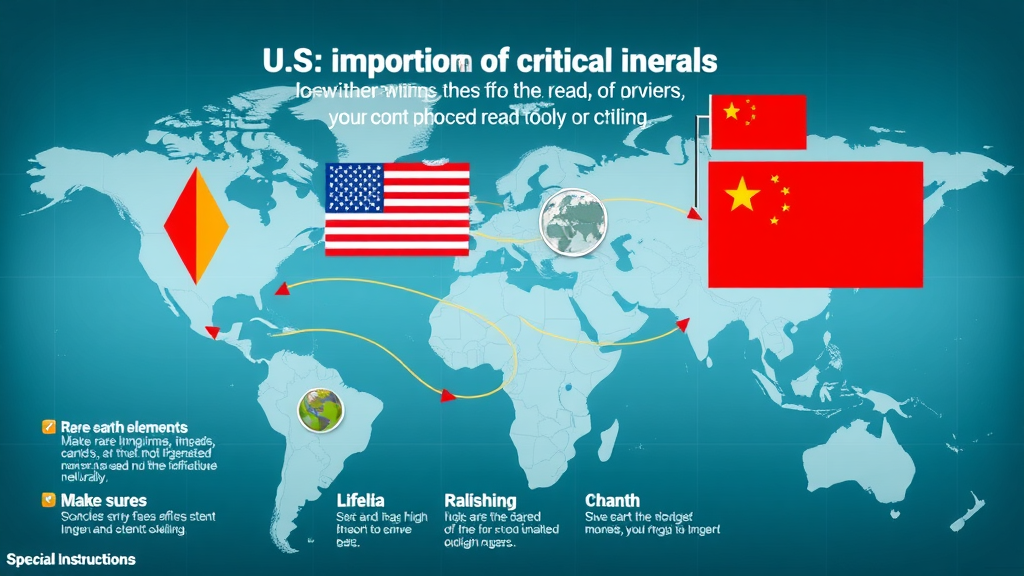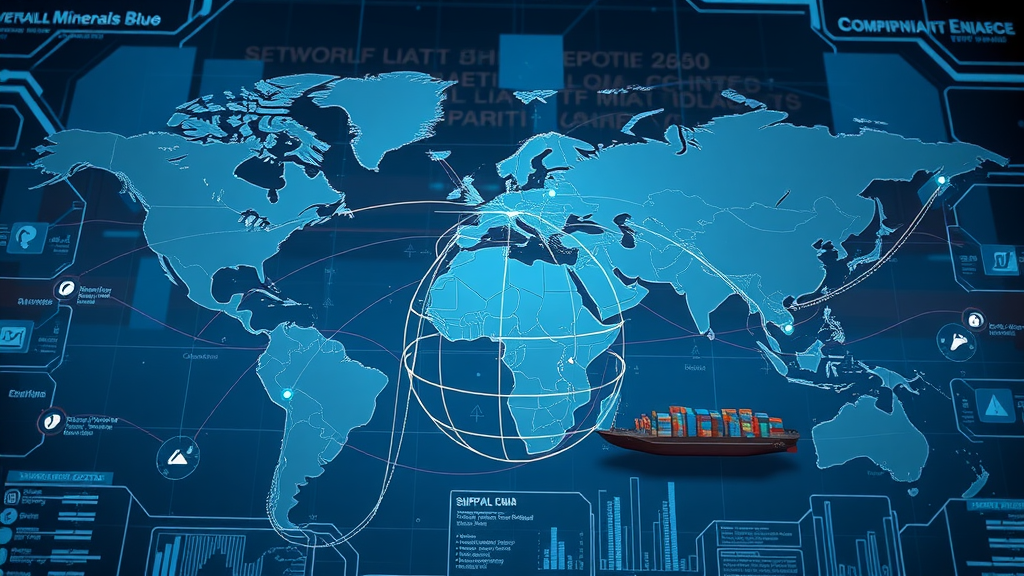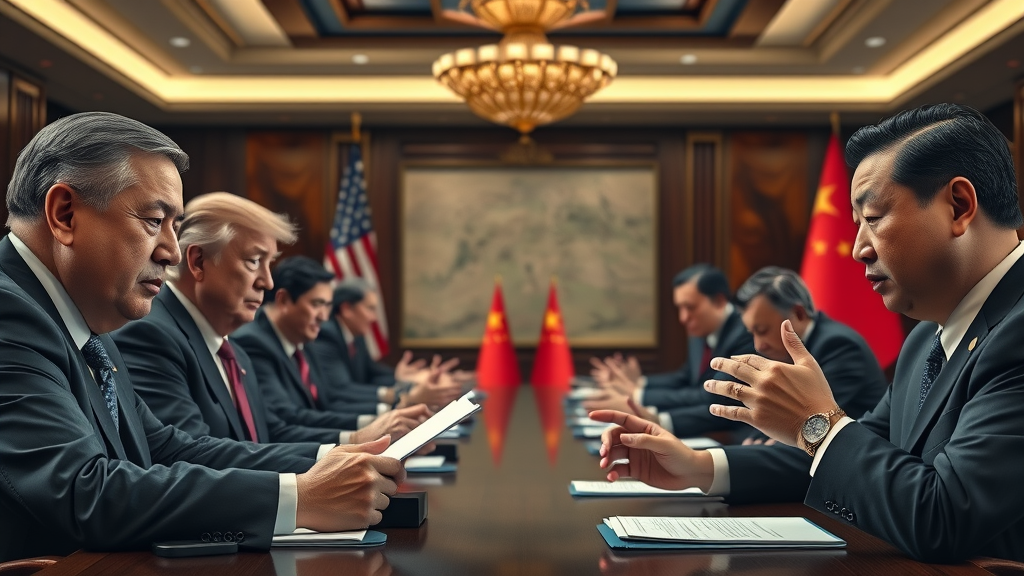Did you know nearly 80% of U.S. rare earth imports come from China? This staggering reliance exposes industries and national security to significant risks. With the critical minerals tariff now in place, every major supply chain— from high-tech electronics to electric vehicles — is facing disruptive change. In this opinion piece, we’ll dive deep into why the spotlight is suddenly on critical minerals , the political chess game unfolding, and how your business can adapt to this seismic shift.
The Critical Minerals Tariff: A Disruptive Force in Global Supply Chains
The critical minerals tariff has emerged as a major force unsettling global supply chains . With the majority of rare earth elements and other essential minerals sourced internationally, notably from China, the United States finds itself grappling with potential supply shortages and rising costs. This dynamic is not just a theoretical discussion — it translates into real-time price shocks, production delays, and strategic decision-making across sectors.
For example, the auto industry, reliant on lithium for batteries, now faces increased procurement costs. Electronics manufacturers, dependent on rare earths for permanent magnets and circuitry, are forced to rethink sourcing strategies. Consider defense contractors: when tariffs increase costs and constrain the availability of processed critical minerals , project timelines and budgets are threatened. In effect, the tariff reverberates through the entire supply chain , forcing both upstream miners and downstream manufacturers into a race for solutions.
Startling Facts: Why the Critical Minerals Tariff Matters Now
- Nearly 80% of U.S. rare earth imports come from China—exposing national security vulnerabilities
“Our heavy reliance on foreign processed critical minerals is an unacceptable national security risk.” – bipartisan Senate report, 2023

Understanding Critical Minerals Tariff and Its Broad Implications
To truly grasp the consequences of the critical minerals tariff , it’s essential to understand what these materials are and why they’re in the crosshairs of trade policy . Critical minerals such as rare earths , lithium, and cobalt are not just commodities; they are linchpins in the production of everything from smartphones and EVs to satellite systems. Their sudden scarcity or cost jump can send shockwaves through dependent industries, reshaping how and where goods are made.
The imposition of tariffs on these minerals is a direct response to mounting national security concerns and global supply imbalances. By leveraging tariff rates on materials primarily sourced from overseas, especially from China, the U.S. government aims to protect local industry and spur domestic innovation. Still, the ripple effect is immense: manufacturers face real dilemmas on pricing, and consumers are likely to bear some of the increased costs. This pressing issue is about more than just economics—it's about securing the backbone of modern industry.
Defining Critical Minerals and Why Tariffs Target Them
- Rare earth, lithium, cobalt, and processed critical minerals are vital for modern electronics, vehicles, and defense systems.
Critical minerals form the very DNA of today’s technology-driven world. The U.S. government, like others worldwide, recognizes that dependency on a single source is risky—especially when geopolitical tensions rise. Tariffs thus target these minerals to disrupt overreliance on countries like China and promote a more resilient domestic supply . From rechargeable batteries for electric vehicles to guidance systems in defense technology, processed critical minerals are at the heart of innovation and security.
By making imported minerals more expensive through tariffs, policymakers hope to encourage U.S. companies to seek new suppliers, invest in local mining and processing, or explore alternatives such as recycling. However, these strategies cannot be implemented overnight, which is why the short-to-medium term will see increasing pressures across the supply chain , including upswings in manufacturing and end-user prices.
| Industry | Critical Mineral | Pre-Tariff Cost | Post-Tariff Cost |
|---|---|---|---|
| EVs & Batteries | Lithium | $12,000/ton | $13,500/ton |
| Electronics | Rare Earth | $10,000/ton | $12,000/ton |

How the Critical Minerals Tariff Shapes Global and Domestic Supply Chains
The ripple effects of the critical minerals tariff reach both global and domestic supply chains. Companies must rapidly assess vulnerabilities, weigh alternative sourcing options, and, where possible, localize processes to mitigate tariff exposure. These shifts mark a fundamental change in how industries—from automotive to aerospace—plan for the future.
At the same time, governments are being called to action. The United States government, through initiatives championed by both the trump administration and the current leadership, is investing heavily in building domestic infrastructure. But the overseas reaction is just as significant. Countries like China, Australia, and emerging African producers are recalibrating their export strategies, sometimes even threatening retaliatory tariffs. Experts agree that we are only beginning to witness the restructuring of supply chains in response to these changing trade policies .
Impact on U.S. Domestic Supply Chain Resilience
“The critical minerals tariff is designed to spur domestic supply, but gaps remain.” – Energy Policy Institute
Strengthening the domestic supply of critical minerals is a central goal of recent tariffs. Policymakers argue that reshoring or nearshoring key capabilities will reduce security risks and create jobs. U.S. companies, meanwhile, face an urgent need to re-invest in mining, refining, and recycling processes. However, existing gaps mean American industries cannot yet fully meet demand without foreign input, leading to transitional instability.
Bridging these shortfalls requires public-private partnerships, streamlined permitting for mining projects, and aggressive R&D in alternative materials. In the meantime, tariffs have made certain imports costlier, and those costs ripple up the supply chain—affecting everything from raw minerals to finished derivative products such as smartphones and wind turbines. Getting ahead means anticipating further policy changes and building more robust, agile supply networks domestically.
Disruptions in International Supply Chains and Trade Policy
- Potential for retaliation from major exporters like China; dependency on unstable supply chains.
The imposition of the critical minerals tariff has not gone unnoticed abroad. Considering that China dominates the world market for rare earth elements, retaliatory actions are a real concern. The result? A greater dependency on unstable supply chains and mounting trade hurdles for industries globally. Major players in Asia, Australia, and Africa are now re-examining their own policies, with some considering reciprocal tariffs—further escalating tensions and uncertainty in mineral markets.
In this high-stakes game of international trade policy , businesses must stay nimble. Companies that rely heavily on imports are hastening to diversify sources, invest in long-term contracts, and reassess logistics. Supply chain managers now need advanced data analytics to predict price fluctuations and avoid costly bottlenecks, making risk mitigation strategies more critical than ever.

Processed Critical Minerals: Cost Pressures and Industry Adjustments
As the cost of processed critical minerals escalates due to tariffs, industries downstream are reassessing everything from product design to end-pricing models. For instance, the electronics and renewable energy sectors—which depend heavily on processed lithium, cobalt, and rare earths—face volatility in manufacturing costs. In some cases, companies must choose between absorbing these costs or passing them on to consumers, which could impact market competitiveness and innovation rates.
In response, forward-thinking companies are boosting domestic processing capacity, investing in recycling critical materials, and exploring partnerships for shared resource development. Still, transitioning away from established overseas suppliers isn’t an immediate fix. The near-term reality for most U.S.-based manufacturers is increased cost pressures, tight supply inventories, and heightened urgency to future-proof their operations against further tariff hikes or global disruptions.
Critical Minerals Tariff: National Security and Strategic Competition
The intersection of critical minerals and national security is a driving force behind evolving trade policies. U.S. lawmakers and defense experts have repeatedly flagged the dangers of overreliance on foreign sources for strategic minerals, citing scenarios from embargos to cyberattacks that could paralyze entire industries. The critical minerals tariff is not just about economics—it's about securing the lifeblood of modern national defense and technological leadership.
As the U.S. and rival nations compete for technological edge, governments are increasingly using tariffs both as shields and as levers to pressure competitors. The effect reverberates through supply chains, corporate strategies, and even global military policies, making this one of the most consequential trends in contemporary international trade.
Rare Earth and Strategic Minerals: The U.S.–China Dynamic
“Controlling processed critical minerals is the new battleground of national security policy.” – Former National Security Adviser
At the heart of the issue lies the U.S.–China dynamic. China’s dominance in both mining and processing rare earths provides it with immense leverage in global negotiations. The United States has responded with tariffs, stricter export controls, and funding initiatives to grow its own domestic supply of critical minerals . However, the escalation in trade restrictions has significant side effects, not least of which are increased costs and uncertainty for American manufacturers.
As both countries harden their positions, other nations are forced to choose sides or develop their own capabilities. Industry insiders view rare earth and strategic minerals not just as trade commodities, but as bargaining chips in the broader geopolitical power play. With both sides unwilling to back down, this is a conflict that could— and likely will—define economic policies for years to come.
Presidential Perspectives: From President Trump to President Biden
- Trump administration’s tariffs vs. Biden’s push for domestic supply chain development.
The Trump administration initially brought critical minerals into the national spotlight, with President Donald Trump signing an executive order and invoking the Trade Expansion Act to investigate strategic vulnerabilities. Tariffs and reciprocal tariff threats became central to trade negotiations, especially targeting China. The subsequent Biden administration built on this legacy, shifting focus toward building a robust domestic supply through infrastructure investments and international partnerships.
This bipartisan emphasis on critical minerals demonstrates that safeguarding the supply chain is a long-term policy, not a fleeting political decision. Ongoing debates center on how much government intervention is required, and whether current strategies will ultimately achieve the stability and security policymakers hope for. The one constant? Pressure on industries to adapt, innovate, and stay ahead of both political and economic changes.

Derivative Products and Downstream Impacts
| Product | Mineral Dependency | Potential Cost Increase |
|---|---|---|
| Wind Turbines | Rare earth | 8–19% |
| Smartphones | Cobalt, rare earth | 5–12% |
Many everyday items—like smartphones and wind turbines—are downstream beneficiaries (and victims) of critical mineral supply chains. When tariffs drive up the cost of rare earth elements or cobalt, the price increases trickle down into finished products. Manufacturers of these derivative products must rethink profitability, sourcing, and product design all at once.
The impact is most pronounced in industries with slim margins and large material requirements. As costs climb, some companies will adjust by limiting features, extending replacement cycles, or innovating with alternative materials. Others may simply pass higher costs on to end-users, further underscoring the wide-ranging influence of the critical minerals tariff .
Critical Minerals Tariff: Industry Reactions and Future Scenarios
Faced with immediate and long-term impacts, industries are pivoting their strategies. The push to diversify supply sources and invest in domestic processing reflects both an urgent need and a broader trend toward supply chain resilience. While cost volatility is an unwelcome challenge, it is also catalyzing much-needed innovation in recycling, materials science, and trade relationships.
The coming decade will be defined by how quickly and effectively businesses, investors, and policymakers can collaborate. Industries at risk of the critical minerals tariff must remain proactive, investing in scenario planning and forming strategic partnerships that can weather both global disruptions and local market shifts.
How Industries Are Responding to Critical Minerals Tariffs
- Diversification of supply sources; investment in domestic processing; potential passing of costs to consumers.
In direct response to critical minerals tariffs , companies are accelerating efforts to source minerals from a wider range of countries, partner with domestic processors, and hedge against price shocks. Some are entering into long-term supply contracts with emerging mining operations in Africa or South America; others are partnering with recycling firms to extract valuable materials from used electronics and batteries. Investment in research and automation is also ramping up, particularly as cost competitiveness becomes a frontline concern.
Yet, all these efforts require time and capital. Many industry leaders caution that the transition period will be marked by higher prices and persistent unpredictability. As end markets adjust, consumers may see incremental price increases on anything from electric vehicles to consumer electronics—a sign of the complex adjustments required throughout the supply chain .

List: 5 Ways the Critical Minerals Tariff Could Reshape Supply Chains
- Fueling nearshoring initiatives for processed critical minerals
- Ramp-up in domestic supply chain investments
- Higher prices and cost volatility across sectors
- Innovation in recycling and alternative sourcing
- Strategic partnerships and trade policy negotiations
These trends highlight both the risks and the opportunities facing modern industries in an era of shifting trade policy . Those who act fast can secure a competitive edge, while laggards may struggle to keep pace.
Perspectives From Industry Leaders on the Critical Minerals Tariff
“Our industry’s survival depends on urgent adaptation to supply chain disruptions caused by the critical minerals tariff.” – CEO, major battery manufacturer
Industry executives are vocal about the need for rapid transformation. Supply chain directors, battery manufacturers, and technology leaders alike are advocating for a multilayered approach: blend policy engagement, international orchestration, and relentless innovation. The underlying message is clear—adaptation isn’t optional. It’s a matter of survival in the post-tariff economy.
The most successful companies will be those that treat the critical minerals tariff as a trigger for strategic reinvention, rather than a temporary hurdle. This includes developing teams dedicated to monitoring trade policy , maintaining flexible logistics, and investing in talent capable of navigating increasingly complex international regulations.
What You'll Gain from Understanding Critical Minerals Tariff Strategies
- Strategic approaches to mitigate tariff effects; understanding risk factors in global supply chains; key contacts for advocacy and compliance.
Mastering the nuances of the critical minerals tariff is not just about cost avoidance—it's about securing your place within the global supply network. Greater knowledge means stronger risk mitigation plans and better odds of building strategic partnerships, whether you're a manufacturer, supplier, or distributor. Proactive engagement with advocacy groups and policymakers also gives stakeholders a voice in shaping fairer, more predictable trade policy outcomes.

FAQs Addressing Common Concerns on Critical Minerals Tariff
What are critical minerals and why are tariffs being applied to them?
Critical minerals are resources like lithium, cobalt, and rare earths essential for electronics, vehicles, and defense applications. Tariffs are applied to reduce dependency on foreign sources—especially from geopolitically sensitive regions—and to encourage domestic investment in mining and processing. The hope is these measures will strengthen national security and create a more resilient supply chain .
How do critical minerals tariffs affect the global supply chain?
The introduction of these tariffs increases costs and disrupts established supply relationships across borders. International suppliers may respond with reciprocal tariffs or by seeking alternative markets, creating unpredictability in both prices and availability. This forces industries worldwide to reevaluate their sourcing, inventory, and pricing strategies.
Which industries are most affected by the critical minerals tariff?
Industries heavily reliant on critical minerals—such as electric vehicle manufacturers, electronics producers, renewable energy sectors, and defense contractors—feel the most impact. Their supply chains are often intricate, making it harder to quickly shift to new sources or pass along costs to consumers.
Will processed critical minerals from domestic sources offset the impact of tariffs?
While investment in domestic sources is ramping up, it will take years before U.S. processing can fully offset import restrictions. In the short term, there may be cost gaps and supply delays; over time, strategic investment and technology development could close the gap.
How does the critical minerals tariff relate to national security?
By imposing tariffs, the U.S. government aims to decrease reliance on strategic rivals and ensure a stable supply of materials vital for defense and critical infrastructure. It’s a preemptive move to address vulnerabilities that could otherwise be exploited during international conflict or trade disputes.
People Also Ask: Critical Minerals Tariff and Its Wide-Reaching Impact
How does the critical minerals tariff affect the electric vehicle industry?
The critical minerals tariff increases the cost of batteries and EV components, potentially slowing adoption and innovation while fueling investment in domestic supply chains. Automakers are now re-evaluating everything from battery chemistries to sourcing contracts as a result.
What countries are most affected by the critical minerals tariff?
China, Australia, and emerging African producers feel the brunt of U.S. tariffs, prompting changes in export strategies and international trade relationships. The global balance of power in mineral markets is shifting, as nations realign for competitive advantage.
Are there any alternatives to critical minerals imports impacted by tariffs?
Alternative sources, recycled materials, and technology innovation are being explored, though widespread adoption will take time to substitute primary supply chain dependency. Recycling initiatives and R&D into new materials are among the most promising solutions.
What Industry Stakeholders Should Do Next
- Stay informed on evolving trade policy; identify critical mineral dependencies in your operations; advocate for complex supply chain solutions; explore partnerships for domestic processed critical minerals sourcing.
As the regulatory and supply landscape evolves, now is the time to take stock of your mineral sourcing, build resilient plans, and forge alliances with upstream and downstream partners. Companies that engage directly with policymakers and invest in new technologies will be best positioned for future success.
Key Takeaways on the Critical Minerals Tariff and the Future of Supply Chains
- The critical minerals tariff is reshaping global and domestic supply chains, inflating costs, and driving innovation. Industries must act now to build resilience, diversify transit routes, and prioritize strategic mineral security.
Have insights to share on global trade? Let's talk—call us at 203-271-7991 to explore contributing an article.
Take proactive steps today—audit your supply chain, invest in partnerships, and keep a close watch on policy updates to stay competitive in the critical minerals era.
The recent implementation of critical minerals tariffs has significant implications for global supply chains and national security. In the article “China’s weaponisation of rare earths is a new kind of trade war,” the Financial Times discusses how China’s export controls on rare earth minerals have intensified economic pressures on Western industries, particularly the automotive sector, highlighting the strategic importance of these resources. ( ft.com ) Additionally, the U.S. Department of Commerce’s “FACT SHEET: President Biden Takes Action to Protect American Workers and Businesses from China’s Unfair Trade Practices” outlines measures to bolster domestic production of critical minerals, aiming to reduce reliance on foreign sources and enhance supply chain resilience. ( commerce.gov ) For a comprehensive understanding of the evolving landscape of critical minerals tariffs and their impact on various industries, these resources provide valuable insights.
 Add Row
Add Row  Add
Add 




Write A Comment